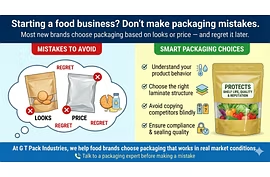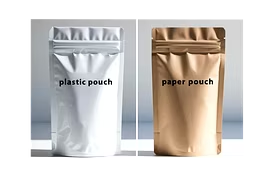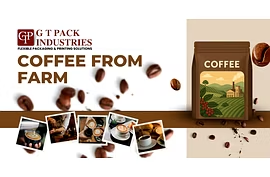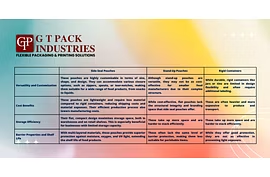Paper Pouches vs. Plastic Pouches – What Should You Choose for Your Product?
| 01 May 2025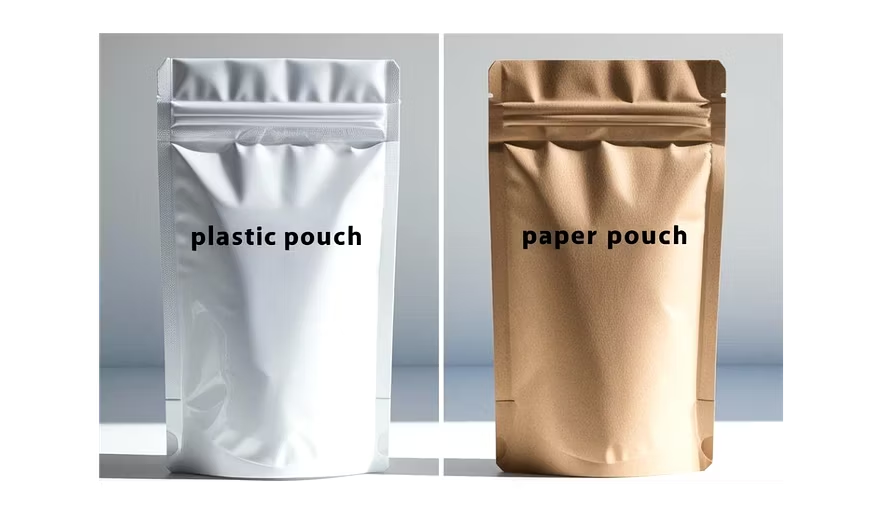
Paper Packaging Pouches vs. Plastic Packaging Pouches:
Which One Is Better for Your Brand?
Let’s be honest—when was the last time you picked something off a shelf just because it looked better than the rest?
It happens more often than we admit. Packaging is no longer just a wrapper. It’s your handshake, your elevator pitch, your silent salesperson. It introduces your brand before a word is spoken or a product is tried.
In this consumer-driven world, packaging is more than a pouches or wrapper for your product—it’s your first impression.
But if you're a business choosing between paper pouches and plastic pouches, that handshake gets complicated.
As industries shift toward sustainability while balancing performance and cost, one debate continues to dominate: paper pouches vs. plastic pouches.
Each comes with its strengths. Each has its drawbacks. And if you're stuck in the middle, wondering what’s really the best choice for your product, you're not alone.
Let’s unpack this—carefully, and from the perspective of a brand that's been helping others figure it out for years.
What Are Paper Packaging Pouches?
Think of those minimalist brown kraft pouches at a farmer’s market. Or the crisp white ones with soft-touch printing you see in premium tea shops, the white or grey ones filled with mouth freshener, printed with restaurant logo you got it after having meal at that place for free. Or the silver sheet you found after opening laminated pouches as an protected layer wrapped around the chocolate. And the best, one you got prescribed tables form pharmaceutical shop. Guess what, That’s paper packaging.
Usually made from poly coated kraft paper, poly coated bleached kraft paper, poly coated chromo paper or laminated paper with coatings (like poly or aluminum), these pouches feel honest.
They tell a story—about nature, sustainability, or artisanal quality.
Technical language : Paper pouches are made from kraft paper, bleached paper, or laminated paper structures (like poly-coated paper or aluminum foil laminatedpaper). They are often used in food, pharma, and retail industries for their eco-friendly appeal, printability, and biodegradable nature.
You’ll often find them used in organic food brands, herbal teas, premium coffees, or pharmaceutical wraps where the product itself is delicate, dry, or health-conscious.
But—and there’s always a but—they're not perfect. More on that soon.
What Are Plastic Packaging Pouches?
These are the real workhorses or should say most dominated category of packaging. But Why?
As they are made from polymers like LDPE, BOPP, or PET, plastic pouches dominate supermarkets and corner stores alike. Why? They’re lightweight, resilient, cost-effective, and versatile.
They’re everywhere—from spicy namkeen pouches, chocolate pouches to washing powder packets to ready-to-eat meal kits. They can be glossy, matte, transparent, opaque, stand-up, zip-locked—you name it.
Technical Language: Plastic pouches are made from polymers such as LDPE, HDPE, BOPP, or PET, either mono-layer or multi-layered. These pouches are known for their strong barrier properties, flexibility, and cost-effectiveness across a wide range of industries—from snacks to detergent powders.
They get the job done. But, yes, they raise eyebrows in sustainability circles.
Side-by-Side Comparison
|
Feature |
Paper Pouches |
Plastic Pouches |
|
Sustainability |
Biodegradable, recyclable (if Uncoated) |
Hard to recycle (multi-layer plastics) |
|
Barrier Protection |
Moderate (can be enhanced with laminates) |
Excellent moisture, air & grease barrier |
|
Print Quality |
Excellent (suits high-end designs) |
Very good with roto gravure printing |
|
Shelf Appeal |
Premium, natural look |
Glossy, vibrant, and mass-market friendly |
|
Weight & Shipping |
Heavier, higher cost |
Lightweight, lower logistics cost |
|
Cost per Unit |
Generally higher |
More economical in bulk |
|
Consumer Perception |
Eco-conscious, premium |
Affordable, durable |
When Should You Choose Paper Pouches?
If you're selling authenticity—or rather, if your brand leans into words like organic, natural, handcrafted, or sustainable, paper might feel like the obvious choice.
Choose paper packaging if your brand is:
- Launching a premium herbal tea line? A kraft paper pouch with a resealable zipper tells your customer they’re buying something mindful.
- Focused on sustainability or natural/organic products.
- Targeting a premium segment with eco-conscious customers.
- Selling dry items like tea (Tea Packaging pouches), coffee(Coffee Packaging pouches), spices(Spices Packaging Material), or pharmaceuticals.
- Looking for plastic-free branding for compliance or marketing.
- Positioning yourself as eco-conscious? Paper says, “we care,” even before the product is tasted.
Example: A premium coffee roaster might use kraft stand-up paper pouches with a degassing valve and custom printing to tell a brand story.
When Should You Choose Plastic Pouches?
Let’s not demonize plastic. It still solves real problems—especially when you’re dealing with volume, preservation, or logistics.
- You need to ship lakhs of units with minimal packaging failures.
- Your product is moist, oily, aromatic, or fragile.
- You require nitrogen flushing, strong sealing, or custom shapes.
- Longer shelf life and excellent barrier protection.
- Cost-effective bulk packaging (especially for FMCG).
- High strength and puncture resistance for heavy items.
- Flexibility in pouch shapes like center seal Pouches, 3-side seal pouches, or stand-up pouches.
For instance, a masala brand shipping across hot, humid regions might be better off with a laminated BOPP pouch than a paper one that buckles or tears.
Plastic gives you performance, precision, and pricing. But yes, it demands that you stay updated on recyclability trends—because the world is watching.
Example: A snack manufacturer needing a high-gloss, full-color printed pillow pouch with nitrogen flushing would benefit more from plastic.
Sustainability Myth-Buster
While paper is often seen as more sustainable, it requires lamination or coating for moisture resistance, which can complicate recycling. Meanwhile, newer technologies are making mono-material plastic pouches recyclable, aligning with global sustainability goals.
Here’s something no one tells you: paper isn’t automatically better.
Most food-grade paper pouches need a plastic layer inside to make them moisture-resistant. That hybrid? Often non-recyclable.
Meanwhile, the packaging world is rapidly evolving. Mono-material plastic pouches—which can be recycled—are gaining ground. Technologies like PCR (Post-Consumer Recycled) films are helping big brands reduce plastic waste without switching to paper.
👉 So, the right choice isn't black and white—it’s about context.
So yes, sustainability is important. But it's not a binary. It's about how your material behaves across its life cycle—not just where it comes from.
A Quick Note from G T Pack Industries
We’ve seen both sides of the debate—because we make both types.
At G T Pack Industries, we manufacture everything from paper-based kraft pouches with heat-seal layers, to high-barrier plastic laminates used by food processors, exporters, and pharma companies alike.
Some clients come to us wanting paper. But once they describe their product's shelf life, humidity exposure, or supply chain complexity, we suggest a hybrid.
Others start with plastic, but later switch to recyclable mono-structures because their customers demanded it.
That’s the beauty of experience. You don't just pick a side—you pick what's right for you.
Whether you need a biodegradable paper pouch for herbal tea, or a high-barrier laminated plastic pouch for masalas, we tailor the structure, design, and finish to your requirements.
Final Thought: The Verdict?
There’s no one-size-fits-all answer.
And honestly? That’s okay.
Because the best packaging choice isn’t a material—it’s a decision that aligns with your product, audience, and brand philosophy.
- If you're targeting a premium, sustainability-conscious market, paper could be your storytelling tool.
-
But if you need scalability, performance, and protection, plastic might just be your safest bet—especially with newer recyclable versions.
At the end of the day, the pouch is your ambassador. Make sure it speaks the language your customers understand—and respect. The real winner is the packaging material that aligns with your product needs, customer values, and brand vision.
Keywords : paper pouch packaging, paper vs plastic pouches, sustainable packaging India, kraft paper pouch manufacturer, laminated paper pouches, plastic pouch packaging, food-grade pouches, eco-friendly pouch options, biodegradable packaging, flexible packaging comparison

